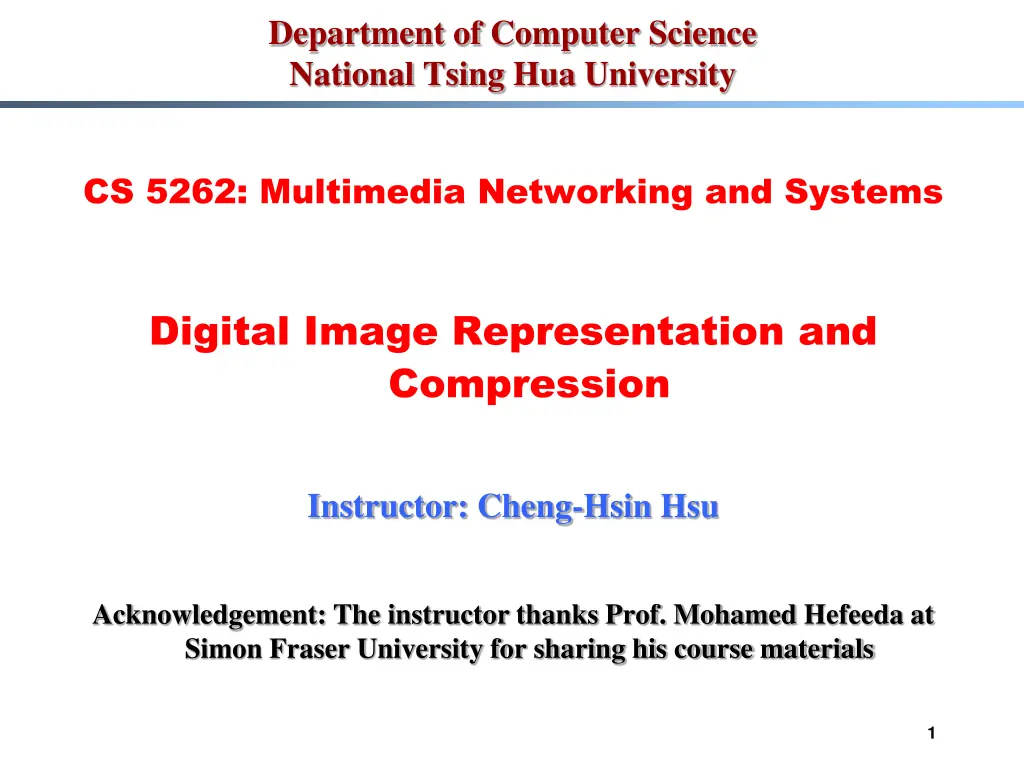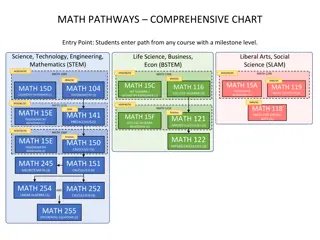
Digital Image Representation and Compression Overview
Explore the fundamentals of digital image representation and compression, covering topics such as analog versus digital signals, sampling, quantization, and the importance of Nyquist frequency. Delve into the process of analog-to-digital conversion and understand how under-sampling and quantization impact signal quality. Enhance your understanding of multimedia networking and systems in this insightful course material from National Tsing Hua University.
Download Presentation

Please find below an Image/Link to download the presentation.
The content on the website is provided AS IS for your information and personal use only. It may not be sold, licensed, or shared on other websites without obtaining consent from the author. If you encounter any issues during the download, it is possible that the publisher has removed the file from their server.
You are allowed to download the files provided on this website for personal or commercial use, subject to the condition that they are used lawfully. All files are the property of their respective owners.
The content on the website is provided AS IS for your information and personal use only. It may not be sold, licensed, or shared on other websites without obtaining consent from the author.
E N D
Presentation Transcript
Department of Computer Science National Tsing Hua University CS 5262: Multimedia Networking and Systems Digital Image Representation and Compression Instructor: Cheng-Hsin Hsu Acknowledgement: The instructor thanks Prof. Mohamed Hefeeda at Simon Fraser University for sharing his course materials 1
Outline Analog & Digital Signals - Sampling & quantization Discrete Cosine Transform Compression Methods Color Models JPEG Compression Some figures in these slides are taken from the online version of the Burg s book: The Science of Digital Media. 2
Analog & Discrete Phenomena Analog: continuous phenomenon, between any two points there exist infinite number of points - Most natural phenomena Discrete: points (either in time or space) are clearly separated Computers work with discrete values to-digital conversion Digital media: - Better quality, less susceptible to noise - More compact to store and transmit (high compression ratios) analog- 3
Analog-to-Digital Conversion: Two Steps Sampling: - choose discrete points at which we measure (sample) the continuous signal - Sampling rate is important to recreate the original signal Quantization: - Represent each sample using a fixed number of bits - Bit depth (or sample size) specifies the precision to represent a value 4
Sampling Nyquist frequency - The minimum sampling rate to reconstruct the original signal: r = 2 f - f is the frequency of the signal Under sampling can produce distorted/different signals (aliasing) 5
Under sampling: Example f = 637 Hz Sampling at 770 (< 2 f) produces a different wave 6
Quantization n bits to represent a digital sample number of different levels is m = 2n max real, continuous, sample values are rounded (approximated) to the nearest levels Some information (precision) could be lost 7
Quantization: Error Signal-to-Quantization-Noise Ratio (SQNR) - Measures amount of error introduced by quantization - ~ max sample value / max quantization error - Measured in decibel (dB) Max quantization error is of quantization level Quantization values range from -2n-1to 2n-1 -1 Max (absolute) quantization value is 2n-1 2 log 1 1 n = ( ) ( ) = n 20 20 log 2 SQNR 10 10 / 2 9
Methods of Creating Digital Images Bitmap images (our focus) - Created pixel by pixel (pixel = picture element) - Commonly used in digital cameras, scanners, - Good for photographic images, where colors change frequently and subtly Vector graphics - Objects are specified by math equations and colors - Useful for clearly delineated shapes and colors, e.g., in cartoon or poster pictures - Used in Adobe Illustrator, Corel Draw, Visio, Omnigraffle, and Xfig Procedural modeling - Computer algorithms employed to generate complex patterns, shapes, and colors 10
Bitmap Images: Sampling & Quantization Consider natural scene, shot by digital camera Sampling: #pixels in x, y - Camera takes x y samples - E.g., 1600 x 1200, limited by camera specs - Pixel: small square, its value = average color in square - Under sampling lack of details : 15 x 20 Quantization: - Each pixel has 3 colors R, G, B - Bit depth: #bits for each of R, G, B - Typical: 8 bits each 224 ~ 16+ m colors - low bit depth patches of colors: 12 colors 11
Representing Images as Waveforms Consider one row in a grayscale image - Pixel values vary Plot pixel value as function of position: - z = f(x,y) Grayscale - 0: black, 255: white Same waveform analysis applies to R, G, B color components 12
Representing Images as Waveforms Complex images waveforms Sudden changes in pixel values (color) frequency components in the waveform (signal) How do we analyze such complex signals? complex high Using Fourier Theory 13
Fourier Analysis Fourier showed that any periodic signal can be decomposed into an infinite sum of sinusoidal waveforms = ( ) f x cos( ) a nwx n = 0 n Sinusoidal waves = frequency components Coefficients = weights of different components This analysis allows us to - determine the signal s frequency components - store complex signals in digital form - filter out unwanted/unimportant components i.e., components that cannot be seen or heard by humans 14
Fourier Analysis: Example Signal that has only three components - All other coefficients are 0 15
Frequency Components of Images Images have discrete points Transform (DCT) Consider one row of M pixels in an image - Can be represented as sum of M weighted cosine functions (called basis functions): Discrete Cosine ( ) + 2 1 r u 2 ( ) C u M 1 M = ( ) f r ( ) cos F u for 0 r M 2 M = 0 u 2 = = ) 1 = where ( ) if 0 otherwise ( C u u C u 2 16
Simple Example 8 pixels with values: [0, 0, 0, 153, 255, 255, 220, 220] We compute weight for each of the eight basis functions 17
Example (contd) Basis function 0 Direct Current (DC) component no change in color Basis function 1 low frequency slow change in color Basis function 2 bit faster change in color 18
Example (contd) Basis function 3 Basis function 4 Basis function 5 19
Example (contd) Basis function 6 Basis function 7 Highest frequency component Notice the rapid change in pixel value (color) 20
Example (contd) When all components are added up with their weights, we get the original row of pixels 21
Two Dimensional DCT We can compute the coefficients (weights) for an M x N image from: ( ) ( ) + + 2 1 2 1 N r u s v 1 1 M N 2 ( ) ( ) C u C v MN s = ( , ) F r s ( , ) cos f u v cos 2 2 M = = 0 M 0 , 0 u v for 0 r N 2 ( ) = = ( ) = where if 0 otherwise 1 C C 2 This is called 2D discrete cosine transform The inverse also exists: swap f(.,.) with F(.,.) 22
DCT: Notes DCT takes bitmap image (matrix of colors) and returns frequency components (matrix of DCT coefficients) In other words, DCT transforms signal from spatial domain to frequency domain DCT usually applied on blocks of 8 x 8 pixels - For efficient computation of coefficients 23
DCT: Notes DC DCT basis functions for 8 x 8 images Squares represent ( ) 2 1 cos cos 2 M ( ) + + 2 1 N r u s v 2 as r, s vary from 0 to 7 Frequency increases as we move right & down - cycle for each square Any 8 x 8 image can be represented by choosing appropriate weights for these basis functions High frequency 24
DCT & Compression Compute DCT for the 8 x 8 image: What do you expect? Not too much color changes few low frequency components DC & Does DCT help in image compression? How? Many coefficients are 0 easy to represent them in compact form 25
Summary Analog (natural) signals are converted to digital by - Sampling (by at least double the signal frequency Nyquist) - Quantization (some loss of info, depending on the quantization step (number of bits used) SQNR) Images can be represented as waveforms (value vs space) Waveforms can be decomposed into essential frequency components using Fourier analysis 2-D DCT is used to analyze images (discrete signals) - Allows us to understand frequency components of an image - Helps in compression 26






















